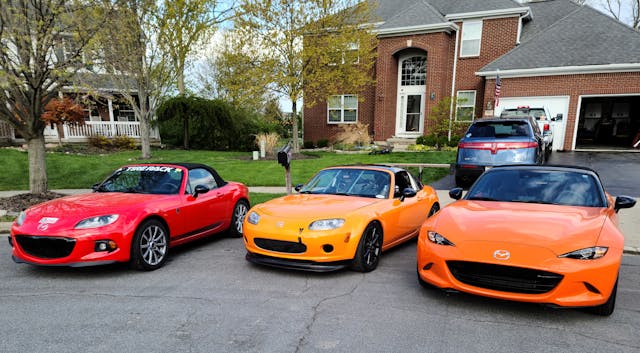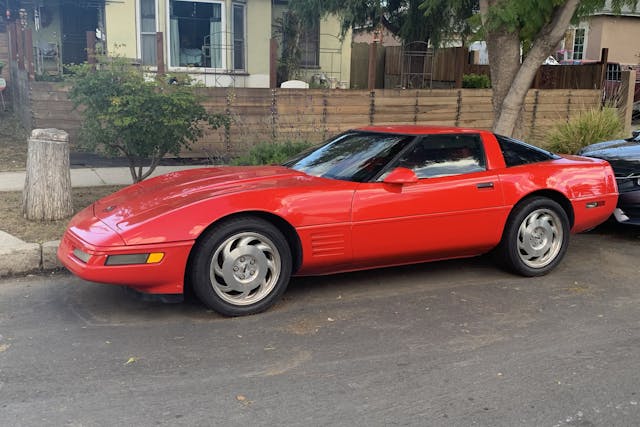Avoidable Contact #103: How the Miata crashed its way to a bull market

Question of the day: When is a Miata worth more than a Corvette? Answer of the day: right now.
Second question of the day: Should you ever listen to me, Jack Baruth, about future investments or career choices? Second answer of the day: Hell no.
I’ll provide definite proof for both answers below. Let’s start with the first one. I bet you don’t know just how wide Hagerty casts its net of automotive services, media, and information. I certainly didn’t when I took this job, just over two years ago. Here’s an example. In order to give you fair value for your classic car in the event the worst should occur, Hagerty relentlessly observes, records, and interprets sale and auction results all across the country. Imagine having your 1993 Supra Turbo hardtop stolen, only to be told that it has a “blue book” value of $1500! That’s what you might get from a lot of insurance companies. Hagerty, on the other hand, knows what Supras are fetching on the open market.
For a long time, we kept this information to ourselves. Then some brilliant and handsome fellow decided it should be shared with anyone who wants it. So now we have a brand new website called Hagerty Insider. It’s devoted to the insights we’ve gleaned from the auctions and high-profile sales. This site doesn’t exactly have universal appeal; if you care more about quarter-mile times than quarter-million-dollar valuations, you’ll find it to be quite dry. For the people who love buying and selling as much, or more, than they love driving and styling, however, it’s a lot of fun.
Every once in a while, our analysts will throw out a fascinating fact or bit of analysis on which I can chew. Here’s the newest one: The values of #2-condition (Excellent) first-gen “NA” Miatas have risen past the values of equivalent-condition Corvettes from the same years. (What’s “#2-condition”? It’s what most people would call a “like new” used car, which is to say it’s not best-in-the-world perfect, but it’s close.) The Miata is the very smallest and weakest boat on a rising tide that has seen the value of Japanese sports cars from the ’90s soar over the past decade. Compared to the aforementioned Supra Turbo, or even its temperamental showroom sibling, the FD RX-7, the Miata isn’t exactly doing a GameStop when it comes to appreciation. Eppur si muove, though.
Values of good LT1-powered C4 Corvettes, on the other hand, have remained relatively flat since 2015. As a consequence, you’ll now pay more money for an excellent ’95 Miata than you would for the equivalent-condition ’95 Vette. Before I give you my unfettered opinion as to just how stupid this is, allow me to offer something in the way of credentials:

This is my driveway, and these are three of my wife’s Miatas: an NC Club she uses for SCCA Time Trial, an NC Cup she uses for SCCA and NASA club racing plus the occasional AER enduro, and her 30th Anniversary ND soft-top. (A fourth Miata couldn’t make it for the photos, because it’s in a state of disassembly.) We cherish Miatas in our household. We really do. I’ve won multiple enduro races in a Miata. I’ve had two podiums (in two starts, boo-yah) in the Skip Barber Mazdaspeed series. I was once the owner of an SCCA-National-Solo-winning C Street Prepared NA Miata. I may be a hick who lives in Ohio, but I am not anti-Miata.
So, with all that said: If you have a choice between a good six-speed 1995 Corvette and a good “NA8” Miata, you’d be borderline insane to pay more for the Mazda. It’s not just that the Chevy is hugely, massively, insanely faster both on paper and in the real world; it’s that the Corvette is more of a driver’s car! It looks cooler. It makes cooler noises. It’s more rewarding to run on the ragged edge, although it takes a bit of antisocial sentiment to run a 300-horse, 255/285-width tire car to the limit on a public road. In the words of the children’s song: Everything the Miata can do, the Corvette can do better. And faster. Backwards. While wearing heels.
But wait, there’s more. The Corvette was available as a convertible or as a targa with a fancy lift-off roof that can supplied by the aftermarket in everything from body color to Boogie Nights Bronze Mirror. While the NA Miata was available with an automatic transmission, that choice takes all the steam out of a car that was already pretty low on motivation. The C4 Vette, by contrast, barely loses a step when equipped with a slushbox. The Corvette has more room inside and is quieter. The convertibles have just as much storage space as a Miata, but the coupes can haul furniture.
Even in the matter of both cars’ most awesome feature—their pop-up headlights—the Chevrolet reigns supreme. The Miata has a conventional hinge mechanism, but the C4’s headlights do a radical 180-degree flip into action! True, the Mazda pulls ahead in categories like “build quality” and “reliability” and “mean time between failures,” but we’re talking sports cars here, not cargo aircraft. And it’s also true that there are great V-8 engine kits for the NA Miata, but the Corvette comes stock with a great V-8, no kit required!

I’d like to think I’ve just convinced you on this matter, but I know that you arrived at this column with an opinion on the matter that won’t be swayed in either direction by my modest efforts. Most people are either “Miata people” or “Corvette people.” (My spouse, who has owned both and competed in both, was firmly on the Miata-person side … until she drove the C7 Grand Sport. Now she’s not sure.) So what’s happened in the past decade? Did the “Miata people” earn more money than the “Corvette people”? Did all the “Corvette people” move to the C5? Did they die? What happened to the demand curve for Miatas and Corvettes between 2014 and today?
Maybe nothing. Maybe it’s the supply curve. 20,742 Corvettes were built for 1995, compared to 19,590 Miatas. The number of usable ’95 examples has declined every year since, as has tended to be the case with every car except the original Ferrari 250 GTO, of which it is said that 36 were built and only 143 remain. Once a car is about fifteen years old, however, the rate of decline tends to, uh, decline, because any remaining examples are now in the hands of careful adult collectors.
Or at least that’s the case with the Corvette. The situation with the Miata is quite different, thanks to its eponymous spec-racing class. How many NA Miatas have become race cars? I don’t know anybody who thinks the number is under three or four thousand. More than a thousand “Spec Miatas” were built during the 1999–2000 season. In the two decades since, the car has become the default motorsports choice—not just for NASA and SCCA, but also for all the cheap-car endurance races out there. I’ve personally seen dozens and dozens of “racing” Miatas built without the Spec Miata kit.
In the same way that there are fifty “house centipedes” in your domicile for every one you happen to see, every Spec Miata on the track represents not just one car taken off the market, but several. When the value of used NA Miatas fell into the three-figure range a while ago, thousands of them were parted-out to keep the racers on the track. Most “SMs” are on their second or third engine. Where did the replacements come from? Hint: The rest of the car got turned into a metal cube.
Spec Miata, as a class, has now firmly settled on the second-generation NB car as the winning formula, but there are still people building and prepping NA variants for lesser forms of club and casual racing. Heck, there are even circle track Miatas. The C4 Corvette, by contrast, has very little motorsports presence. A few people road race them, and there was a brief period in time when a six-speed L98 Corvette was the best way to win Solo Nationals and Showroom Stock, but when it was time to create a “Spec Corvette” class, the founders settled on the C5, not the C4, citing the more modern car’s speed, balance, and component availability.
All of the above leads me to conclude that the supply of condition #2 Miatas is far less than the supply of condition #2 Corvettes. This has consequences for the market, and those consequences have finally come home to roost. It also, as a sidebar, explains why the values of the FD RX-7 are so high: Those cars have engines with the half-life of protactinium-219 and unibodies with profound love of rusting.
What does this mean to you, the would-be appreciator of appreciating automobiles? Perhaps it means that you should keep an eye on the supply of your chosen collector car as closely as you watch the demand. This bodes well for the NC Miata, which is now becoming a very popular “track rat” and club race car, and for the bulk of McLaren supercars, which are crashed with mind-numbing regularity by people who have difficulty making the mental adjustment between their daily-driven Land Cruisers and a 600-plus-horse supercar with a polar moment of inertia on par with that of a child’s spinning top made of magnesium.
By the same token, the tremendous care given to late-model Corvettes and Shelby Mustangs by their very diligent owners suggests that these cars won’t experience a Miata-style supply crunch anytime soon. That being said, remember my second question above: Should you ever listen to me, Jack Baruth, about future investments or career choices? Let me give you a hint on that. When I came to Hagerty in 2019, I gave up a very nice senior position in a career field that I felt had zero potential for further advancement, and that field was online and remote learning for primary and secondary students. Had I stayed in the Zoom-school business … well, let’s just say I’d already have my dream car, which as you all know is the Genesis G90 5.0 Ultimate.
Oh well. Hindsight is 20/20. If you want to cast a sharp eye on today’s market values, however, I’d recommend you give Hagerty Insider a look. Something to think about, as you’re looking: If the standard ’95 Corvette is a great deal right now, what would you call the ’95 ZR-1? Even a Miata fanatic should be able to come up with the right answer for that question.

